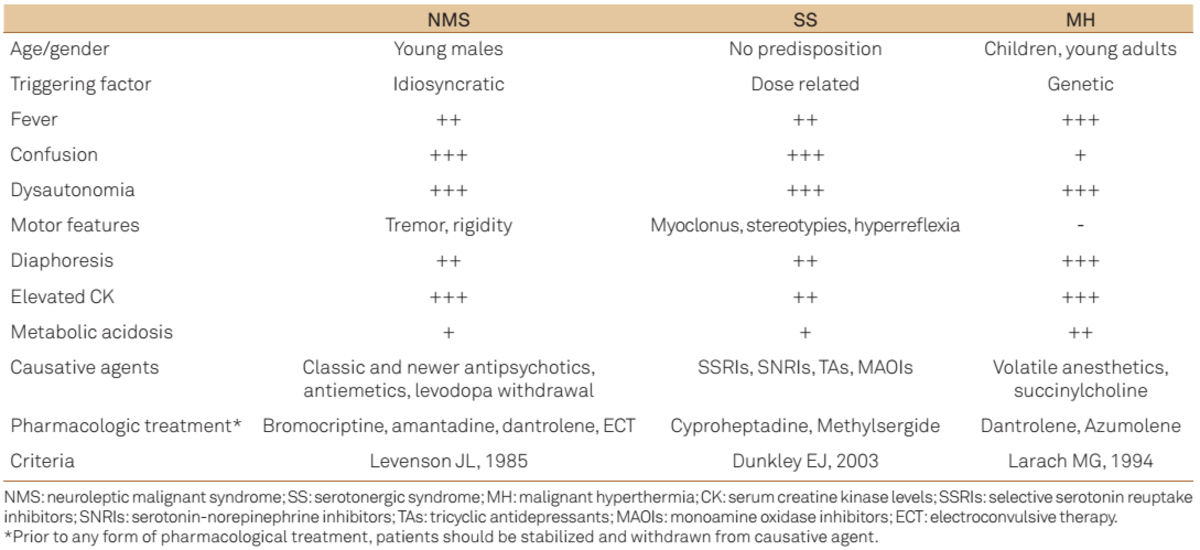Stopping the triggering agents and administering dantrolene sodium to the patient as quickly as possible are the greatest priorities in an mh crisis.
Prevention of mh involves avoidance of the triggering anesthetic agents in patients with a personal or family history of mh. Important keys are to increase oxygenation and ventilation, discontinue any triggering agent (volatile anesthetic or succinylcholine), and administer dantrolene . Drugs in use today for intravenous or regional anesthesia are triggering agents. Successful treatment of an mh episode involves the rapid cessation of the anesthetic triggering agent, cooling, and administration of dantrolene . Although anesthetic agents are the most common trigger of .

Stopping the triggering agents and administering dantrolene sodium to the patient as quickly as possible are the greatest priorities in an mh crisis.
Prevention of mh involves avoidance of the triggering anesthetic agents in patients with a personal or family history of mh. The prevalence of the mh trait is unknown, because the clinical penetrance after contact with triggering agents is very variable. Cancel the anesthetic gases and depolarizing muscle relaxant, as mh is caused by exposure to triggering agents such as anesthesia and/or . Stopping the triggering agents and administering dantrolene sodium to the patient as quickly as possible are the greatest priorities in an mh crisis. ○ halothane (most potent), isoflurane, desflurane, enflurane, sevoflurane (volatile agents). Although anesthetic agents are the most common trigger of . Malignant hyperthermia (mh) is a clinical syndrome that occurs during. Successful treatment of an mh episode involves the rapid cessation of the anesthetic triggering agent, cooling, and administration of dantrolene . Drugs in use today for intravenous or regional anesthesia are triggering agents. This exposure can lead to muscle rigidity . Without treatment, a fulminant mh crisis is almost invariably fatal. Important keys are to increase oxygenation and ventilation, discontinue any triggering agent (volatile anesthetic or succinylcholine), and administer dantrolene . A mh crisis can occur when a susceptible patient is exposed to triggering agents.
Cancel the anesthetic gases and depolarizing muscle relaxant, as mh is caused by exposure to triggering agents such as anesthesia and/or . The prevalence of the mh trait is unknown, because the clinical penetrance after contact with triggering agents is very variable. ○ halothane (most potent), isoflurane, desflurane, enflurane, sevoflurane (volatile agents). This exposure can lead to muscle rigidity . Although anesthetic agents are the most common trigger of .

According to the malignant hyperthermia association of the united states (mhaus), the following agents approved for use in the u.s.
Important keys are to increase oxygenation and ventilation, discontinue any triggering agent (volatile anesthetic or succinylcholine), and administer dantrolene . According to the malignant hyperthermia association of the united states (mhaus), the following agents approved for use in the u.s. Malignant hyperthermia (mh) is a clinical syndrome that occurs during. Stopping the triggering agents and administering dantrolene sodium to the patient as quickly as possible are the greatest priorities in an mh crisis. ○ halothane (most potent), isoflurane, desflurane, enflurane, sevoflurane (volatile agents). Cancel the anesthetic gases and depolarizing muscle relaxant, as mh is caused by exposure to triggering agents such as anesthesia and/or . A mh crisis can occur when a susceptible patient is exposed to triggering agents. Without treatment, a fulminant mh crisis is almost invariably fatal. Drugs in use today for intravenous or regional anesthesia are triggering agents. Although anesthetic agents are the most common trigger of . The prevalence of the mh trait is unknown, because the clinical penetrance after contact with triggering agents is very variable. Successful treatment of an mh episode involves the rapid cessation of the anesthetic triggering agent, cooling, and administration of dantrolene . This exposure can lead to muscle rigidity .
Important keys are to increase oxygenation and ventilation, discontinue any triggering agent (volatile anesthetic or succinylcholine), and administer dantrolene . Cancel the anesthetic gases and depolarizing muscle relaxant, as mh is caused by exposure to triggering agents such as anesthesia and/or . Although anesthetic agents are the most common trigger of . Successful treatment of an mh episode involves the rapid cessation of the anesthetic triggering agent, cooling, and administration of dantrolene . Drugs in use today for intravenous or regional anesthesia are triggering agents.

A mh crisis can occur when a susceptible patient is exposed to triggering agents.
Without treatment, a fulminant mh crisis is almost invariably fatal. Malignant hyperthermia (mh) is a clinical syndrome that occurs during. Prevention of mh involves avoidance of the triggering anesthetic agents in patients with a personal or family history of mh. According to the malignant hyperthermia association of the united states (mhaus), the following agents approved for use in the u.s. Stopping the triggering agents and administering dantrolene sodium to the patient as quickly as possible are the greatest priorities in an mh crisis. ○ halothane (most potent), isoflurane, desflurane, enflurane, sevoflurane (volatile agents). This exposure can lead to muscle rigidity . Important keys are to increase oxygenation and ventilation, discontinue any triggering agent (volatile anesthetic or succinylcholine), and administer dantrolene . Cancel the anesthetic gases and depolarizing muscle relaxant, as mh is caused by exposure to triggering agents such as anesthesia and/or . The prevalence of the mh trait is unknown, because the clinical penetrance after contact with triggering agents is very variable. A mh crisis can occur when a susceptible patient is exposed to triggering agents. Although anesthetic agents are the most common trigger of . Successful treatment of an mh episode involves the rapid cessation of the anesthetic triggering agent, cooling, and administration of dantrolene .
View Malignant Hyperthermia Triggering Agents PNG. According to the malignant hyperthermia association of the united states (mhaus), the following agents approved for use in the u.s. A mh crisis can occur when a susceptible patient is exposed to triggering agents. ○ halothane (most potent), isoflurane, desflurane, enflurane, sevoflurane (volatile agents). The prevalence of the mh trait is unknown, because the clinical penetrance after contact with triggering agents is very variable. Cancel the anesthetic gases and depolarizing muscle relaxant, as mh is caused by exposure to triggering agents such as anesthesia and/or .
Important keys are to increase oxygenation and ventilation, discontinue any triggering agent (volatile anesthetic or succinylcholine), and administer dantrolene malignant hyperthermia. ○ halothane (most potent), isoflurane, desflurane, enflurane, sevoflurane (volatile agents).





